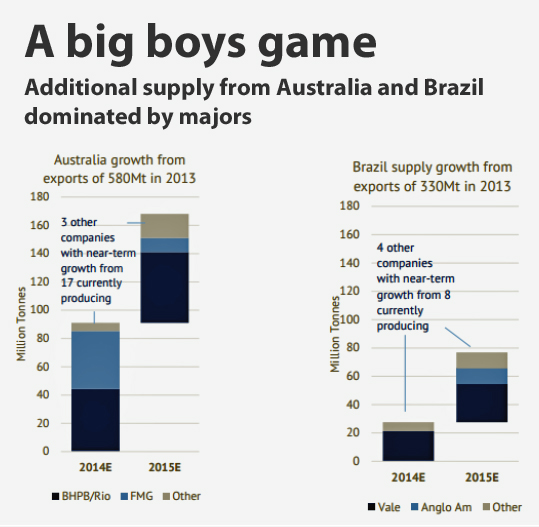Dire Chinese steel outlook drops iron ore price to 7-year low

Don’t look down now, but the bottom is falling out of the iron ore price
The spot price of iron ore fell further into uncharted territory on Wednesday with the steelmaking raw material declining to the lowest since the inception of the spot pricing system amid a widening supply glut and fresh fears about demand from top consumer China.
The 62% Fe import price including freight and insurance at the Chinese port of Tianjin lost $0.80 or 1.4% to $57.70 a tonne on Wednesday. After almost halving in 2014, the price of iron ore is now down more than 23% this year.
Wednesday’s peg was the lowest price since November 2008 when The SteelIndex, a unit of Platts, first started tracking the spot price. In 2008, the benchmark contract price was $60.80 a tonne, which was hiked from the annually-set price in 2007 of $36.63.
Iron ore is the second largest commodity trade globally after oil. With many of the same factors at work in the market, the fall in the price of seaborne iron ore has been even more dramatic than that of crude oil.
Simply put, a flood of new low cost supply has swamped the market, leaving only a handful of producers to increase their dominance of the industry.
According to Morgan Stanley, an investment bank, the global surplus will surge to 437 million tonnes in 2018 from 184 million tonnes this year. That’s an astonishing number considering the seaborne trade is likely to hit 1.4 billion tonnes this year (and with a slowing China responsible for over two-thirds of the total).
Other estimates are more modest, but there is a growing consensus that the market will likely be in oversupply for the rest of decade.
The additional tonnes – an extra 100 million tonnes could hit the market in 2015 – have mostly come from the largest producers which are set to corner 85% of the market (making it vastly more concentrated that the crude industry).
Led by the Big 3 – Vale, Rio Tinto and BHP – and Fortescue Metals Group iron ore miners invested north of $100 billion in new projects and expansions since the start of the decade which pushed the market into surplus for the first time mid-2014.
Rio Tinto is well on its way to reach 360 million tonnes in the next few years. BHP Billiton’ is on target to grow capacity to 290 million tonnes per year by mid-2017. Unlisted miner Hancock Prospecting’s Roy Hill could start shipping 55-million tonnes-a-year as early as September 2015, while world number four producer FMG have hit targeted production of 155 million tonnes per year right on time.

Dozens of marginal producers shut down last year but another 175 million tonnes will have to be displaced to neutralize 2015 output growth, which unlike copper is de-risked. (Source: MVS Research)
Top producer Vale plans to boost Brazilian output to 450 million tonnes by 2018 from 306 million last year, while Anglo American’s Minas Rio project in the country will ramp up to 26.5 million tonnes per year during 2015.
Even more damaging to marginal producers, the top three miners have been cutting costs and making the most of per unit volume savings – Rio Tinto said last month it’s cash costs are now at $18 a tonne, BHP’s is just above $20 after falling nearly 30% over the last six months while Vale is also closing in on the sub-$20 mark.
While the iron ore story is mostly about supply, demand is also clouding the outlook. China’s steel production is slowing after 30-years of breakneck expansion as the country’s infrastructure investment slows together with the pace of urbanization. Amid an intensifying Beijing crackdown on overcapacity and polluting industries, steel production fell more than 4% in January compared to 2014.
Domestic forecasts are now more dire than that of suppliers to the country.
In his first speech as the new chairman of the China Iron & Steel Association (CISA), Zhang Guangning said last month that China’s steel industry had already hit a “peak” in 2014. At 823 million tonnes, that’s at least 20% below most forecasts.
No amount of growth in other steel markets could make up the slack – number two producer Europe’s output was 169 million tonnes last year. The US, the healthiest global economy, produced only around 12% of the Chinese total and as Zhang pointed out nearly all production growth in China was absorbed by exports rather than domestic demand.
According to TheSteelindex, another key government body, the Ministry of Industry and Information Technology (MIIT), said the industry would remain in contraction through 2015 amid a continuation of low prices and squeezed margins. In a separate presentation, Wu Wenzhang, the president of steel market consultancy SteelHome, said Chinese steel demand might contract by as much as 100 million tonnes by 2025.
More News
{{ commodity.name }}
{{ post.title }}
{{ post.date }}



Comments